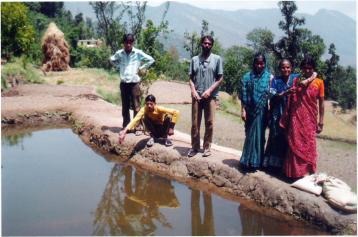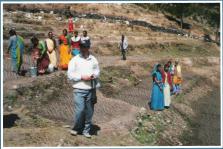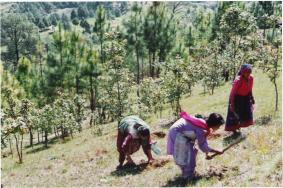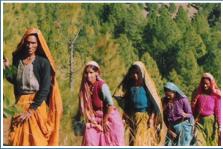1. Improved livelihoods through biodiversity and innovative farming (2003-2008)
 A three-year sustainable development project for village Nagilagaon, Pithoragarh district, Kumaon, inspired by the motivation and energy of the young Sarpanch of the village, The Himalaya Trust undertook to support this project in 2006 for a period of three years.
A three-year sustainable development project for village Nagilagaon, Pithoragarh district, Kumaon, inspired by the motivation and energy of the young Sarpanch of the village, The Himalaya Trust undertook to support this project in 2006 for a period of three years.
People’s Plan for Change: Convinced that a slight shift away from conventional farming practices would improve the biodiversity of the area, increase farm output and conserve forests and water, the community was encouraged to plan this project their way. Their ideas were pooled together to implement a variety of activities of their choice, depending on slope and aspect of the land, soil quality, and ability of the farm family.
In three years, the village has 10 thriving poly houses producing vegetables for sale, three experimental fishponds for young widows, a green plantation of fodder and commercial tree species to benefit the women, rosemary cultivation, vermi-compost pits for forty families, and cardamom bushes which have made good use of the boggy areas.
The community has undertaken to continue the work through seven thrift and credit societies. Training aspects for developing skills in all the above activities are being taken care of by neighbouring NGOs with expertise. The future looks brighter, now that these diverse ways of farming have started bringing in additional income.
 Nagilagaon at nearly 6,500’ASL is located on the watershed of the Ramganga River in Kumaon, and commands a spectacular view of the Himalayan range of Nanda Devi, Trisul and Panchachuli. There are 120 families in Nagilagaon, a mixed community of farmers and artisans, almost all classified as Below Povery Line (BPL).
Nagilagaon at nearly 6,500’ASL is located on the watershed of the Ramganga River in Kumaon, and commands a spectacular view of the Himalayan range of Nanda Devi, Trisul and Panchachuli. There are 120 families in Nagilagaon, a mixed community of farmers and artisans, almost all classified as Below Povery Line (BPL).
2. Women and Forests: Lohathal Conservation and Reforestation (2000-2003)
Lohathal is a large village of highland farmers whose rich agricultural lands are well irrigated by the abundance of streams that emerge from its thick forests of oak, alnus and rhododendron.
 As part of the forests bounded on the north by a Musk Deer farm were being grazed the neighbouring villages, the women led by Leela Karki, secretary of the Mahila Mangal Dal, appealed to the Himalaya Trust to help with reforesting the degraded area with natural broadleaved tree species, and wall off the 5 ha identified for the conservation work. The regenerated forests will also restore the natural ecosystem conditions necessary to grow medicinal herbs and fodder plants and grasses which the women plan to sell to the musk deer farm. During the three –year project period a series of troughs and ponds were dug for water conservation, banj seeds were collected by the women from mother trees in the forest and planted directly into small pits. With protection the forest floor has sprung to life with an abundance of Vajradanti, majethi, brahmi, and other aromatic plants, while dense stands of oak (banj), rhododendron and alnus have come up. The women have plans to sell fodder to the Musk Deer farm adjoining their forest.
As part of the forests bounded on the north by a Musk Deer farm were being grazed the neighbouring villages, the women led by Leela Karki, secretary of the Mahila Mangal Dal, appealed to the Himalaya Trust to help with reforesting the degraded area with natural broadleaved tree species, and wall off the 5 ha identified for the conservation work. The regenerated forests will also restore the natural ecosystem conditions necessary to grow medicinal herbs and fodder plants and grasses which the women plan to sell to the musk deer farm. During the three –year project period a series of troughs and ponds were dug for water conservation, banj seeds were collected by the women from mother trees in the forest and planted directly into small pits. With protection the forest floor has sprung to life with an abundance of Vajradanti, majethi, brahmi, and other aromatic plants, while dense stands of oak (banj), rhododendron and alnus have come up. The women have plans to sell fodder to the Musk Deer farm adjoining their forest.
3. Phalyanti Women’s forestry project (1997-2002)
 Forty-nine members of the Mahila Mangal Dal (women’s council) undertook the task of converting 25 ha of “chir” pine forests into a plantation of mixed broad leaved species of greater use to the community for fodder, fuel, humus and food. Inspired by Diksha Bisht, the women worked at transforming their forest despite the depredations of wild animals, lack of rain, the dangerous forest fires, and opposition of vested interests. 1,25,000 saplings were planted, apart from direct sowing of oak seeds . The women achieved an outstanding 60% rate of survival. Within one year they were able to start selling grass to other villages, making a neat profit for their women’s council. With the disappearance of the Chir Pine and regeneration of natural forest species, the acute water shortage felt by the village each summer has eased as several nature springs have been recharged.
Forty-nine members of the Mahila Mangal Dal (women’s council) undertook the task of converting 25 ha of “chir” pine forests into a plantation of mixed broad leaved species of greater use to the community for fodder, fuel, humus and food. Inspired by Diksha Bisht, the women worked at transforming their forest despite the depredations of wild animals, lack of rain, the dangerous forest fires, and opposition of vested interests. 1,25,000 saplings were planted, apart from direct sowing of oak seeds . The women achieved an outstanding 60% rate of survival. Within one year they were able to start selling grass to other villages, making a neat profit for their women’s council. With the disappearance of the Chir Pine and regeneration of natural forest species, the acute water shortage felt by the village each summer has eased as several nature springs have been recharged.
The green forests of banj, phalyant, uttish and burans, all of immense economic value to these ecosystem communities, stand as a tribute to the long-term vision of the women of Phalyanti.
4. Gainwali: Conservation of medicinal and herbal plants
Gainwali, a remote village in Tehri Garhwal undertook a medicinal plant cultivation project through its Yuvak Sangathans, led by Bachhan Singh Rawat. A 2 ha nursery was created with highly sought medicinal herbs at a cost of Rs. 60,000. Young persons from Gainwali and neighbouring villages were trained to identify and raise herbs from seed. The success of the venture has inspired a number of neighbouring villages to cultivating herbs and medicinal plants which fetch them a high price in the market.
